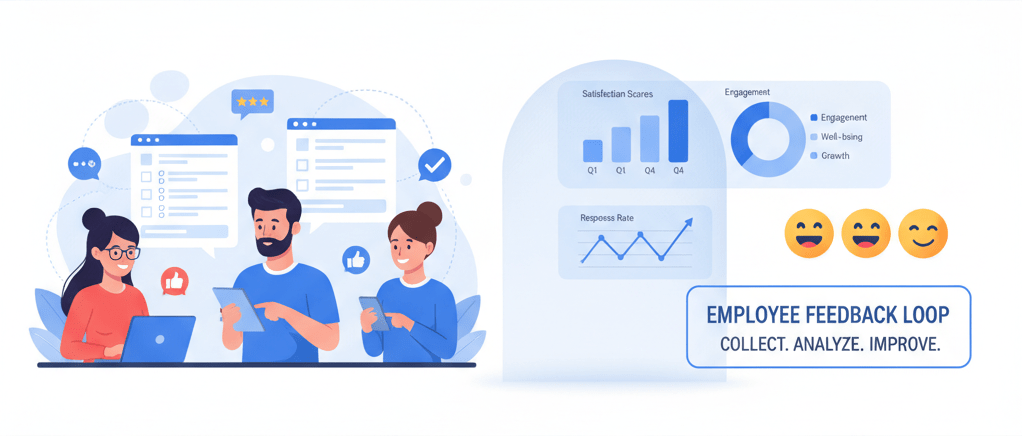“Automate feedback collection and deepen employee understanding: Use automated employee satisfaction surveys driven by conversational AI for richer, real-time insights.”
You’ve been there before. The annual employee satisfaction survey results are in. You eagerly open the dashboard, hoping for a treasure trove of insights that will help you build a better workplace. Instead, you find a desert. A sea of lukewarm “4 out of 5” ratings. A handful of one-sentence comments in the open-feedback boxes, like “Things are fine” or “More communication would be good.”
It’s frustrating. You invest time and resources into these surveys, but the return is minimal. The data is flat. It tells you what employees might be feeling, but it gives you absolutely no insight into why. You’re left guessing, trying to create action plans based on vague numbers and generic comments. You’re trying to solve a complex human puzzle with a tool that’s as blunt as a hammer.
This isn’t a new problem. For decades, we’ve relied on the same static forms, star ratings, and text boxes to measure the unmeasurable: human experience at work. But these tools are fundamentally flawed. They are a one-way street in a world that demands a two-way conversation.
What if you could change that? What if, instead of sending out another lifeless form, you could deploy a friendly, empathetic listener to have a genuine conversation with every single employee? A listener who could ask intelligent follow-up questions, dig deeper into their feedback, and make them feel truly heard.
This isn’t science fiction. This is the power of conversational AI, and it’s completely changing the game for automated employee satisfaction surveys. This new approach moves beyond sterile data points and uncovers the rich, nuanced stories behind employee experiences. It’s time to stop guessing and start understanding.

The Great Disconnect: Why Your Traditional Surveys Are Failing
Before we dive into the solution, we need to be brutally honest about why the old methods no longer work. The problem isn’t your employees; it’s the outdated tools you’re giving them. They are built on a shaky psychological foundation that practically guarantees disengaged, low-quality feedback.
The Tyranny of the Star Rating
On the surface, star ratings and Likert scales (the “strongly agree” to “strongly disagree” options) seem efficient. They’re easy to answer and even easier to aggregate into neat charts and rising or falling eNPS scores. But this efficiency comes at a steep price: context.
Think about the last time you rated an experience “4 out of 5 stars.” What did that really mean?
- For one person, a four means, “It was great, but nothing is ever perfect.”
- For another, a four means, “It was mostly good, but there was one significant issue that I’m not going to bother writing about.”
- For a third, a 4 is a safe, neutral choice. It’s the path of least resistance.
This is a well-documented phenomenon called central tendency bias. Most people instinctively avoid extremes. Giving a “5” feels overly enthusiastic, while providing a “1” feels overly critical and might attract unwanted attention. So, the majority of responses cluster in the middle, creating a mound of meaningless 3s and 4s.
Your dashboard might show an average score of 3.8 for “Manager Effectiveness,” but this number tells you nothing. Is it a 3.8 because everyone feels their manager is slightly above average? Or is it a 3.8 because half the team thinks their manager is a 5-star superstar, while the other half thinks they’re a 2-star micromanager? The average hides the truth. It flattens the peaks and valleys of human experience into a boring, unhelpful plateau. Star ratings give you a number, but they rob you of the story.
The Terror of the Blank Textbox
“Okay,” you might think, “that’s why we include an open-ended feedback box! That’s where we get the real gems.”
In theory, yes. In reality, that little text box is often the most intimidating part of the survey. It’s a blank canvas that most employees don’t have the time, energy, or psychological safety to fill out thoughtfully.
Consider the employee’s perspective. They’ve just clicked through 20 questions with star ratings. Now they’re faced with a box and a blinking cursor. A few things happen here:
- Sudden Writer’s Block: It’s hard to summarize complex feelings about your job on the spot. Where do you even begin? It’s much easier to write “No comment” or a generic platitude and move on.
- The Fear Factor: Even when a survey is labeled “anonymous,” people are skeptical. They worry their writing style, their choice of words, or a specific anecdote could be used to identify them. This fear is a potent inhibitor of honest feedback. So, instead of providing a detailed critique of a flawed process, they might just write “Could be more efficient,” which is utterly useless to you.
- It’s a Monologue, Not a Dialogue: The biggest flaw of the text box is its static nature. An employee might write, “I feel like there aren’t enough growth opportunities.” A traditional survey has no response to this. It can’t ask, “That’s important feedback. Can you tell me more about what kind of growth you’re looking for?” or “Have you discussed this with your manager?” The conversation ends the moment they hit “submit.” You get a breadcrumb of information when you need the whole trail.
This combination of survey fatigue, fear, and the sheer effort required to articulate nuanced thoughts means that your most valuable feedback—the kind that could genuinely help you improve company culture—remains unspoken.
A New Conversation: How AI Is Redefining Employee Feedback
Imagine you wanted to know how your best friend was really doing. Would you send them a multiple-choice form? Of course not. You’d sit down with them, ask an open-ended question like, “How have things been lately?” and then listen. You would ask follow-up questions. You would respond with empathy. You would have a conversation.
This is the simple but profound idea behind conversational AI surveys. Instead of a static form, you deploy an AI agent that engages each employee in a natural, text-based chat. It’s the difference between filling out a tax form and talking to a trusted advisor.
This isn’t your typical customer service chatbot that answers basic questions. This is a highly specialized AI designed to ask questions, understand the nuances of human language, and dynamically guide a conversation to uncover deep insights.
Creating a Safe Space for Honesty
One of the most surprising discoveries in this field is that people are often more open and honest with an AI than with a human or a form. Why? Psychological safety.
A well-designed AI agent is non-judgmental. It has no biases. It doesn’t have a bad day. It doesn’t have a relationship with the employee’s manager. This perceived neutrality creates a uniquely safe space. An employee who would never dream of writing down a criticism of a new company policy for fear of being seen as “negative” might feel perfectly comfortable expressing that same sentiment in a conversation with a neutral AI.
The AI can be programmed to be endlessly patient and empathetic. It can start the conversation with phrases like, “Thanks for taking a few minutes to chat. Your perspective is really valuable to us,” and respond to negative feedback with, “I’m sorry to hear that’s been your experience. We must understand this better.” This empathetic approach lowers defenses and encourages people to open up, providing the kind of anonymous feedback that is both genuine and constructive.
The Magic of Dynamic Follow-Up Questions
This is where conversational surveys truly surpass traditional methods. Unlike a static form, a conversational AI can adapt in real-time. It listens to an employee’s response and asks intelligent, relevant follow-up questions.
Let’s revisit our earlier examples:
- Traditional Survey:
- Question: Please provide any additional feedback.
- Answer: There aren’t enough growth opportunities.
- Result: You have a vague data point. You know someone is unhappy about growth, but you don’t know what kind of growth, in what role, or why they feel that way.
- Conversational AI Survey:
- AI: “Thanks for sharing that. It’s beneficial to know what’s on your mind. When you say ‘growth opportunities,’ what does that look like for you?”
- Employee: “Well, I’m a software engineer, and I’d love to get more experience with project leadership, but it seems like only senior engineers get those roles.”
- AI: “I see. It’s about getting a chance to lead smaller projects and build those skills. Is that right?”
- Employee: “Exactly! I’d even be happy to shadow someone or take a course, but there’s no clear path for that.”
Look at the difference. In just two follow-up questions, you’ve gone from a vague complaint (“no growth”) to a particular, actionable insight: “Our engineers need a clear career path that includes opportunities for leadership development on smaller-scale projects.” This is the kind of detail that allows you to make meaningful changes, moving beyond simple employee pulse surveys to what feels more like automated stay interviews.
From Raw Conversation to Powerful HR Analytics
Conversational surveys generate a lot of rich, qualitative text. That sounds great, but it also sounds like a nightmare to analyze, right? Who has time to read through hundreds of conversation transcripts?
This is where the second layer of AI magic comes in. Modern conversational AI platforms not only conduct interviews but also analyze the results, transforming messy human language into clean, powerful HR analytics.
Seeing the Forest and the Trees
Advanced AI algorithms can analyze every conversation and provide sophisticated insights automatically and in real-time.
- Sentiment Analysis: The AI can instantly identify the sentiment (positive, negative, neutral) associated with every sentence. It can then tag these sentiments to specific topics. Your analytics dashboard may indicate that the overall sentiment is 80% positive, but the sentiment related explicitly to “work-life balance” is 65% negative. This immediately tells you where to focus your attention.
- Thematic & Topic Analysis: This is a game-changer. The AI can identify the key themes and topics that emerge from the conversations without any human intervention. You might think the biggest issue is compensation, but the AI might reveal that the most frequently discussed negative topic is actually “inefficient internal meetings” or “outdated software tools.” These are the hidden friction points that kill productivity and morale but rarely show up on a standard survey.
- Keyword Extraction: The system can pull out the most frequently used nouns and verbs, giving you a quick cloud of what’s on your employees’ minds. Seeing words like “burnout,” “deadlines,” and “communication” appear in large font on your dashboard is a powerful signal.
This automated analysis turns a flood of qualitative data into a structured, searchable goldmine. You get the depth of a one-on-one interview with the scale and speed of a quantitative survey. It’s the best of both worlds.
Proactive Culture-Building, Not Reactive Problem-Solving
Traditional annual surveys give you a snapshot in time. You get a report once a year, and by the time you’ve analyzed it and created an action plan, the data is already six months old. The problems may have worsened, or new ones may have emerged.
Conversational AI enables a more agile approach. You can deploy these agents for quick employee pulse surveys after a major company change, a new policy rollout, or just as a regular monthly check-in.
Imagine you just launched a new performance review process. Instead of waiting a year to find out if it’s working, you could deploy a conversational agent a month later to ask, “Hey, we’d love to get your early thoughts on the new review process. What went well, and what could be improved?”
The real-time insights dashboard could show you within days if a specific part of the process is causing confusion or frustration. You can then intervene immediately to rectify the issue. This transforms HR from a reactive, report-generating function into a proactive, strategic partner that actively shapes and improves the employee experience day by day. This is how you build a truly responsive organization and authentically improve company culture.
Making It Happen: The Power of No-Code AI
Until recently, building a custom AI agent like this would have required a team of expensive developers and data scientists. It was a luxury reserved for giant tech companies.
That has all changed. The rise of no-code AI platforms has put this incredible power directly into the hands of HR teams. You no longer need to write a single line of code to build a sophisticated, empathetic, and insightful conversational survey agent. If you can write an email, you can make an AI.
These platforms offer a straightforward, intuitive interface that allows you to define the AI’s personality, its goals, and its initial questions. You can tell it, “Your name is Sparky. You are a friendly and curious team mascot. Your goal is to find out what’s making work feel energizing for our team this month. Start by asking, ‘What’s one thing that gave you a boost of energy at work recently?'”
The platform handles all the complex technology in the background—the natural language processing, the conversation flow, and the data analysis. It empowers you, the HR professional, to focus on what you do best: understanding people.
Scalewise.ai: Your Free, No-Code Tool for Better Feedback
Among the new wave of no-code tools, Scalewise.ai stands out as the ideal solution for HR teams looking to modernize their feedback process. It’s a powerful, flexible, and—most importantly—free No-Code AI Agent Builder.
Scalewise.ai was designed with this exact use case in mind. It enables anyone to create and deploy custom AI agents for automated employee satisfaction surveys in just minutes.
Here’s how simple it is to transform your feedback process with Scalewise.ai:
- Define Your Agent: You begin by assigning a name and personality to your AI agent. Do you want it to be professional and formal? Or friendly and casual? You decide. You provide it with a simple prompt, like, “You are an empathetic HR partner. Your goal is to conduct a confidential stay interview to understand what keeps our top performers engaged.”
- Set the Opening Line: You craft the first question. This could be broad, like “How are you feeling about your role right now?” or specific, like “We’ve just finished our big product launch. How are you feeling post-launch?”
- Deploy with a Link: Scalewise.ai generates a simple, shareable link for your AI agent. You can email it, post it in Slack, or embed it on your intranet. There’s no complex software for employees to install. They just click the link and start chatting.
- Watch the Insights Roll In: As employees interact with your agent, you’ll see the anonymized conversations and analytics appear on your dashboard in real time. You can immediately spot trends, identify key themes, and read the rich, detailed stories behind the data.
With Scalewise.ai, you can move beyond the annual survey and build a continuous listening strategy. You can create agents for:
- Onboarding Check-ins: For new hires at the 30, 60, and 90-day marks.
- Exit Interviews: To get truly candid feedback when an employee is leaving.
- Pulse Surveys: Quick, regular check-ins on team morale or specific projects.
- DEI Feedback: To create a safe channel for conversations about diversity, equity, and inclusion.
- Stay Interviews: To proactively understand why your best people stick around so that you can do more of it.
The possibilities are endless, and the barrier to entry is zero. You can start building a more engaged and understood workforce today, for free.
It’s Time to Stop Surveying and Start Conversing
The way we work has undergone significant changes. It’s more flexible, more digital, and more focused on the human experience than ever before. Yet, the tools we use to listen to our employees are stuck in the past.
Star ratings and text boxes are artifacts of a bygone era. They are low-resolution tools in a high-definition world. They keep you at a distance, giving you charts and graphs instead of clarity and connection. To truly boost employee engagement and build a culture where people thrive, you need to get closer to your employees. You need to understand the stories, the frustrations, and the aspirations of your people.
Conversational AI is the bridge. It combines the empathy and depth of a human conversation with the scale and analytical power of technology. It allows you to give every employee a voice and, more importantly, the feeling of being heard.
Stop chasing meaningless metrics and fighting fires with incomplete information. Start having better conversations.
Visit Scalewise.ai today and build your first conversational survey agent for free. Discover what your employees are really thinking.
Frequently Asked Questions (FAQs)
Q1: Is the feedback collected by an AI agent truly anonymous?
Yes, absolutely. Platforms like Scalewise.ai are built on the principle of anonymity. The system is designed to strip any personally identifiable information from the responses before presenting them on the analytics dashboard. As an administrator, you see the aggregated themes, sentiment scores, and anonymized transcripts, but you cannot trace a specific comment back to an individual employee. This technical safeguard is crucial for building the trust needed to get honest feedback.
Q2: Will my employees feel awkward or weird talking to a “robot”?
It’s a valid question. While the concept may seem new to some, several factors make the adoption surprisingly smooth. First, people are becoming increasingly comfortable with text-based interfaces, such as messaging apps. Second, the AI is positioned as a confidential feedback tool, not a new digital coworker. You can introduce it as “a new, confidential way for you to share your thoughts directly with leadership.” Finally, studies and real-world experience have shown that the non-judgmental nature of the AI often makes people more comfortable sharing than they would be with a person. The initial novelty quickly gives way to the benefit of having a safe, private listening ear.
Q3: How is a conversational survey agent different from a regular company chatbot?
This is a key distinction. Most chatbots you encounter are reactive. They are programmed with a knowledge base to answer questions they are asked (e.g., “What is our vacation policy?”). A conversational survey agent is proactive. Its primary goal is not to answer questions, but to ask them. It guides the conversation, listens to responses, and asks intelligent follow-up questions to gather deep qualitative insight on a specific topic. Think of it as an expert interviewer, not a walking FAQ document.
Q4: We already have survey tools built into our HRIS platform. Why do we need another tool?
Your existing HRIS tools are likely built around the traditional model of scales and text boxes. They are great for tracking quantitative metrics, such as eNPS scores or headcount. Scalewise.ai doesn’t replace these systems; it supercharges them. It provides the missing “why” behind the “what” that your HRIS tracks. While your HRIS can tell you that engagement scores in the engineering department dropped by 10%, a conversational agent can tell you it’s because they feel their new project management software is hindering their workflow. It’s a fundamentally different methodology for gathering a much richer form of data.
Q5: How much technical skill do I need to build an agent with Scalewise.ai?
Zero. That’s the beauty of a no-code platform. If you can write a clear set of instructions in plain English, you can build a powerful AI agent. The interface is designed for HR professionals, not developers. You’ll focus on the strategy of the conversation—the agent’s persona, the goals, and the key questions—not on code, servers, or APIs. It’s about your people skills, not your technical skills.
Q6: What kind of insights can we get besides just a bunch of text?
While the raw text is valuable, the real power lies in the AI-driven analysis. From the conversational data, a platform like Scalewise.ai automatically generates powerful HR analytics. This includes interactive dashboards that display overall sentiment trends over time, a breakdown of sentiment by key themes (such as “management,” “compensation,” or “work-life balance”), and word clouds that highlight the most frequently discussed topics. It turns thousands of words of unstructured conversation into structured, easy-to-digest, and actionable insights for your leadership team.





